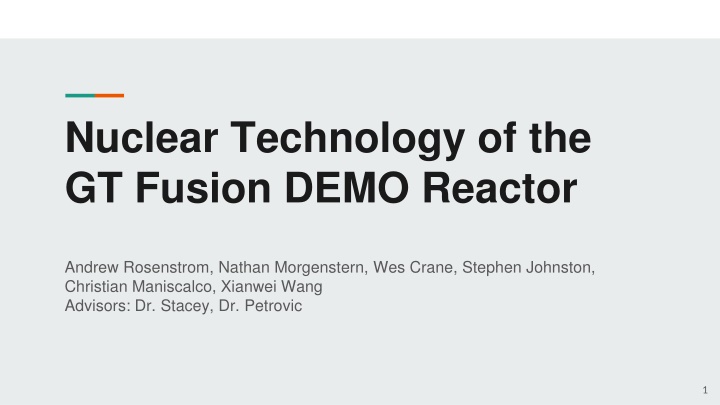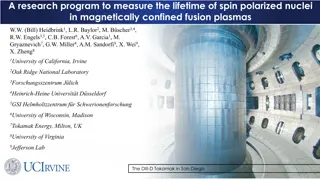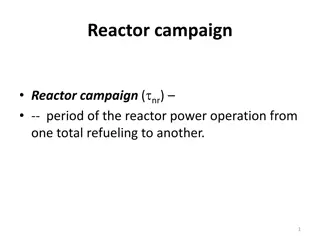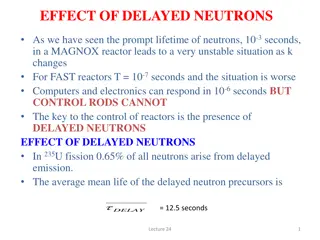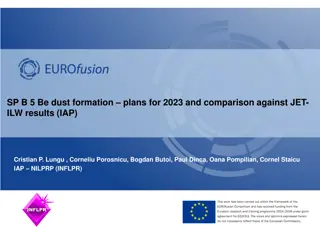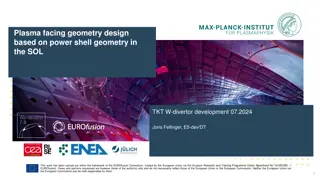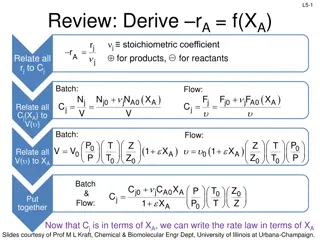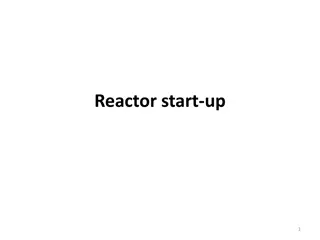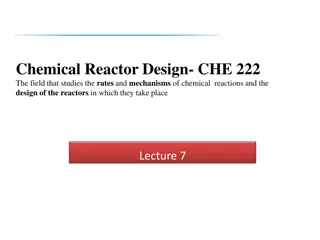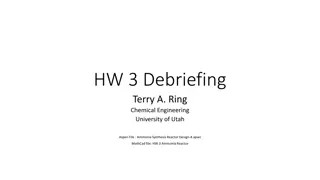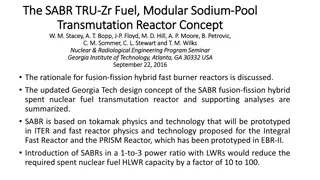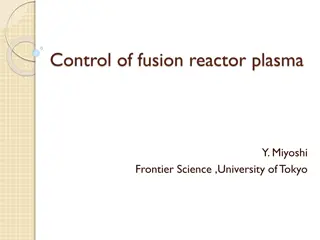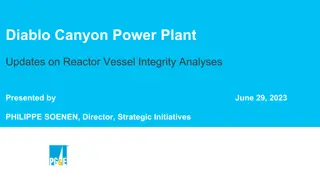Advancements in Fusion Reactor Technology: A Comprehensive Overview
This presentation delves into the nuclear design aspects, objectives, background, and state-of-the-art components of the GT Fusion DEMO Reactor project. It covers key areas such as tritium breeding ratio, neutron transport, temperature distribution, and material choices for optimal reactor performance. The evolution of fusion energy from experimental reactors to current initiatives like ITER is outlined, highlighting the progress and challenges in sustainable fusion energy development.
Download Presentation

Please find below an Image/Link to download the presentation.
The content on the website is provided AS IS for your information and personal use only. It may not be sold, licensed, or shared on other websites without obtaining consent from the author.If you encounter any issues during the download, it is possible that the publisher has removed the file from their server.
You are allowed to download the files provided on this website for personal or commercial use, subject to the condition that they are used lawfully. All files are the property of their respective owners.
The content on the website is provided AS IS for your information and personal use only. It may not be sold, licensed, or shared on other websites without obtaining consent from the author.
E N D
Presentation Transcript
Nuclear Technology of the GT Fusion DEMO Reactor Andrew Rosenstrom, Nathan Morgenstern, Wes Crane, Stephen Johnston, Christian Maniscalco, Xianwei Wang Advisors: Dr. Stacey, Dr. Petrovic 1
Objectives The design project will undertake the nuclear design (neutron transport, temperature distribution, stress analysis, radiation damage lifetime, tritium self-sufficiency) of this Fusion DEMO, consisting of the following: Evaluate the tritium breeding ratio and tritium self-sufficiency. Determine flux distribution throughout the blanket and at the magnet systems. Neutronics Evaluate energy deposition in blanket to determine temperature distribution and heat removal. Conduct coupled thermal and stress analysis. Nuclear Heating Determine the lifetime of magnet and breeding systems. Estimate replacement intervals of first wall and diverter. Radiation Damage 2
Background Pursuit of sustainable fusion energy began with plans for experimental power reactors once the deuterium-tritium fusion interaction was more closely studied in the later years of the 1970's First plasma achieved in a tokamak reactor using magnetic confinement in JET (UK) 1980 Plans for the International Thermonuclear Experimental Reactor were set into motion JET Tokomak continues to produce record breaking amounts of power while its magnetic confinement design becomes the standard for future projects 1990 First instances of deuterium-tritium plasma making for a higher standard of power output alongside a more stable operation become standard 2000 Timetable for the future of the fusion DEMO project presented in 2004 to IAEA for construction to begin in 2024 and end 2033 looking to generate marketable power Start of building construction for ITER project in 2010 after agreement in 2006 2010 3
State Of The Art Advancing design of the latest models of fusion reactors focuses on certain main components: Tritium Breeding Blanket The amount of tritium used in ratio to the amount of tritium produced by a breeding material is the Tritium Breeding Ratio (TBR) and is of high importance in making fusion viable Lithium composites makes a strong tritium producer, and here will be in a ceramic mixture Shielding Materials Radiation resistant materials are necessary to durability, and have been researched to reveal Eurofer 97, or ODS Steel, as the best choice among others (Be, W) Coolant Among coolant options explored, water provides the most stable heat transfer 4
Motivation Fuel for fusion is abundant in the form of deuterium that can be found in water, while tritium can be produced by the lithium/neutron reaction that will occur in the core. Fusion energy is clean. It produces no greenhouse gases, only helium and a high energy neutron. Additionally, there are no dangerous fission products that are associated with most nuclear reactors. Fusion reactors are inherently safe. Any malfunctions in the reactor will cause the plasma to cool and the reactions to cease. No meltdowns or runaway reactions will occur. 5 5
Scope This project will only be to design a water cooled ceramic breeder blanket and will not consider other methods of cooling or breeding. The neutronics modeling in MCNP will not consist of a detailed blanket module design. For simplicity the TBM will be treated as a homogenous mixture. The tritium recovery system and external coolant systems will not be considered; however, the blanket modules will be designed with anticipation of their eventual removal and replacement. Component lifetimes will not take into account damage created from transient plasma disruptions. The system will be assumed at steady-state. Divertor lifetime will not consider charged particle flux from the convergence of magnetic field lines. ANSYS will be used to simulate thermal/stress analysis, considering the cell with the maximum heat flux as determined by MCNP. 6
Design Basis Conceptual Design of a Water Cooled Breeder Blanket [2] Subcritical Advanced Burner Reactor [1] 7
Success Metrics TBR 1.15 Radiation Damage Limits Magnets - 2x1022>1 MeV [n / m2][3] Blanket Structure - 200 dpa Significant Li Burnup will not occur within the lifetime of the reactor. Graphite Shielding - N/A First Wall - 200 dpa Lifetime Temperature distribution within Li4SiO4operational parameters. 325 to 925 degrees celsius First Wall: >20 Effective Full Power Years Blanket: >20Yr 8
Test Blanket Module Design Red - Graphite Shield Green - ODS Steel Blue - Homogenous Breeding Blanket a = 50 cm b = 5 cm c = 300 cm d = 100 cm 9
Coolant System Design Radius (cm) 956.5 958 961.5 966.5 976.5 986.5 996.5 1006.5 1016.5 1026.5 1036.5 1046.5 Poloidal spacing (cm) 1.70 1.70 1.17 2.52 6.64 6.72 6.81 6.89 6.98 7.06 7.14 7.23 Poloidal spacing including tube (cm) 3.20 3.20 2.67 4.02 8.14 8.22 8.31 8.39 8.48 8.56 8.64 8.73 Number of tubes at r 1878 1878 2260 1510 754 753 753 753 753 753 753 753 Protection layer with the thickness of 3 mm Circular channels are used Blanket Coolant Tube Spacing FW Finite Element ANSYS Model 11
Homogenous Material Composition Tritium Breeding Blanket: Eurofer 97 [3]: Atom Total of atoms Number Atom Fraction Element Nominal Percentage Li 4.24E+30 2.05E-01 C 0.46 Si 1.06E+30 5.12E-02 O 4.25E+30 2.05E-01 Si 0.11 C 2.32E+27 1.12E-04 Mn 0.38 Mn 1.91E+27 9.23E-05 Fe 88.96 Fe 4.48E+29 2.16E-02 Cr 4.33E+28 2.09E-03 Cr 8.6 Ta 2.01E+26 9.71E-06 Ta 0.04 V 1.06E+27 5.10E-05 W 1.51E+27 7.29E-05 V 0.21 H 2.63E+28 1.27E-03 W 0.3 Be 1.06E+31 5.14E-01 12
Calculation of Critical Values Using MCNP6 Results Tallies used: F2, F4 and F6 MCNP6 using the following equation to preform tally multiplication. ? ?(?)?(?)?? In the equation (E) is the flux in particles/cm2 and R(E) is the response function from the MCNP cross-section libraries for a given tally multiplier. If the constant C is the particles generated per second, 5.326E20 and is multiplied by the atomic density in atoms per centimeter barn the results of the multiplication will be in reactions/cm3sec. 13
Flux On First Wall/Vacuum Vessel 24 25 2 26 27 6 Cell Area [cm2] Flux [n/cm2s] Uncertainty Cell Area [cm2] Flux [n/cm2s] Uncertainty 28 19 2 6 2.38E+05 1.97E+05 4.06E+05 4.06E+05 4.06E+05 4.06E+05 4.06E+05 1.42E+05 5.92E+14 6.57E+14 6.91E+14 7.14E+14 7.06E+14 6.77E+14 6.15E+14 6.22E+14 0.0052 0.0048 0.0033 0.0032 0.0032 0.0033 0.0036 0.0056 25/30 26/31 27/32 28/33 29/34 35 36 37 5.48E+05 6.06E+05 1.20E+06 1.03E+06 1.19E+06 3.04E+05 5.34E+05 3.46E+05 6.49E+14 6.73E+14 6.94E+14 7.15E+14 3.71E+14 4.35E+14 2.93E+14 4.20E+14 0.0029 0.0028 0.0021 0.0022 0.0029 0.0057 0.0051 0.0053 29 20 19 20 21 22 23 24 21 34 22 33 32 23 31 36 30 35 14 37
Neutron and Photon Flux Distribution Photon Flux [p/cm2s] Neutron Flux [n/cm2s] 15
Flux at Magnet Systems Inboard Toroidal Magnet System Flux of 8.7179E12 [n/m2s] with a uncertainty of 0.0168 of neutrons greater than 1 MeV Would take 2.3566E9 seconds or 72 years of full power operation to reach fluence limit. Outer Toroidal Magnet Systems Flux of 4.07E11 [n/m2s] with a uncertainty of 0.0125 of neutrons greater than 1 MeV Would take 4.991E10 seconds or 1557 years to reach fluence limit. 16
Heating of the First Wall 24 25 2 26 FW Volumetric Heating [MeV/cm3s] 27 Cell F6 Tally Output [MeV/g] FW Heating [MeV/g*sec] Uncertainty 6 2 6 19 20 21 22 23 24 25 26 27 28 29 30 31 32 33 34 1.58E-08 1.76E-08 2.02E-08 2.19E-08 2.18E-08 2.01E-08 1.58E-08 1.68E-08 1.89E-08 2.01E-08 2.11E-08 2.21E-08 2.30E-08 1.85E-08 1.97E-08 2.09E-08 2.21E-08 2.30E-08 7.96E-09 6.22E-08 8.44E+12 9.39E+12 1.08E+13 1.17E+13 1.16E+13 1.07E+13 8.42E+12 8.93E+12 1.01E+13 1.07E+13 1.12E+13 1.18E+13 1.22E+13 9.87E+12 1.05E+13 1.12E+13 1.18E+13 1.22E+13 4.24E+12 3.31E+13 6.60E+13 7.34E+13 8.41E+13 9.11E+13 9.11E+13 8.38E+13 6.59E+13 6.98E+13 7.87E+13 8.40E+13 8.79E+13 9.22E+13 9.57E+13 7.72E+13 8.21E+13 8.73E+13 9.23E+13 9.58E+13 3.32E+13 2.59E+14 0.0022 0.0023 0.0015 0.0015 0.0015 0.0015 0.0017 0.0025 0.0018 0.0017 0.0012 0.0012 0.0011 0.0018 0.0017 0.0012 0.0012 0.0011 0.003 0.0025 28 19 29 20 21 34 22 33 32 23 31 36 35/37 36 30 35 17 37
Heating of the Blanket Cell Volume [cm3] Mass [g] Density[g/cm3] Heating of Blanket [MeV/g*s] 1.79E+13 1.61E+12 1.59E+10 1.38E+11 1.65E+13 1.46E+12 1.27E+11 1.42E+10 2.58E+10 1.90E+11 1.86E+12 1.69E+13 1.46E+13 1.64E+12 1.82E+11 3.17E+10 Heating of Blanket [W/cm3] 1.3148 0.1180 0.0012 0.0101 1.2133 0.1072 0.0093 0.0010 0.0019 0.0140 0.1364 1.2415 1.0706 0.1204 0.0134 0.0023 Uncertainty 12 39 47 48 14 44 49 50 55 56 57 58 15 43 53 54 4.99E+07 5.89E+07 7.77E+07 6.81E+07 6.05E+07 6.97E+07 7.93E+07 8.91E+07 3.83E+07 3.83E+07 3.83E+07 3.83E+07 3.26E+07 3.26E+07 3.26E+07 3.26E+07 1.09E+08 1.28E+08 1.69E+08 1.48E+08 1.32E+08 1.52E+08 1.73E+08 1.94E+08 8.34E+07 8.34E+07 8.34E+07 8.34E+07 7.11E+07 7.11E+07 7.11E+07 7.11E+07 2.1791 2.1791 2.1791 2.1791 2.1791 2.1791 2.1791 2.1791 2.1791 2.1791 2.1791 2.1791 2.1791 2.1791 2.1791 2.1791 0.0024 0.0061 0.0326 0.0118 0.0022 0.0059 0.0114 0.0334 0.0331 0.0133 0.0072 0.0028 0.0033 0.0083 0.0141 0.0291 18
FW Fluid-solid coupling analysis: temp calculation Based on MCNP results, the blanket cell with the max heat flux is chosen to perform temperature calculation. Thermal boundary: inlet temp: 280 C, heat flux density: 0.3 MWm-2, heat deposition: 15.3 MWm-3 outlet inlet Water temp distribution FW temp distribution 20
FW Thermal/Stress Analysis: under water pressure Boundary condition: water pressure 15 MPa, fixed at the end surfaces, symmetry constraint at the bottom surface The max stress is within the threshold, the deformation can be neglected Smax=56.3 MPa Total displacement Shear Stress 21
FW Thermal/Stress Analysis: under water pressure & heat flux Boundary condition: water pressure, heat flux derived from fluid-solid coupling analysis The maximum shear stress is below the limiting stress value of 320 MPa at the first wall temperatures Shear Stress Total Displacement Shear Stress On Armor 22
FW Thermal/Stress Analysis: stress linearization The large stress region (corner) is selected to carry out stress linearization; the membrane stress, bending stress, and thermal stress are determined. 105 Stress Pa Path 1 10-2 Distance m The Path of Stress Linearization Stress Linearization 23
Blanket Temperature Distribution Region Average Temperature (0 Celsius) Average Temperature (340 Celsius) 955 - 959 cm 959 - 964 cm 335 339 675 678 964 - 969 cm 969 981.5 cm 981.5 - 991.5 cm 991.5 - 1005 cm 341 341 341 340 679 680 679 679 24
Radiation Damage: FW 24 25 2 26 Displacements per second 3.43E+17 3.78E+17 3.98E+17 4.11E+17 4.34E+17 4.54E+17 3.34E+17 3.71E+17 4.14E+17 4.44E+17 4.44E+17 4.11E+17 3.38E+17 3.72E+17 3.86E+17 4.08E+17 4.30E+17 4.53E+17 2.04E+17 1.46E+18 1.93E+17 Cell Uncertainty DPA/Year Years to 200 DPA 27 6 24 25 26 27 28 29 2 6 19 20 21 22 23 30 31 32 33 34 35 36 37 0.0051 0.0037 0.0034 0.0024 0.0025 0.0024 0.0046 0.0049 0.0034 0.0033 0.0033 0.0034 0.0037 0.0036 0.0034 0.0023 0.0025 0.0024 0.0058 0.0049 0.0045 10.83 11.92 12.54 12.97 13.68 14.32 10.53 11.69 13.07 14.01 13.99 12.96 10.65 11.73 12.18 12.87 13.56 14.29 6.45 46.04 6.07 18.47 16.78 15.95 15.42 14.62 13.97 18.99 17.11 15.30 14.28 14.30 15.44 18.79 17.05 16.42 15.54 14.75 14.00 31.02 4.34 32.93 28 19 29 20 21 34 22 33 32 23 31 36 30 35 25 37
Radiation Damage: Blanket Displacements per second 7.43E+16 5.19E+15 4.04E+14 3.77E+13 9.06E+16 7.17E+15 4.44E+14 2.57E+13 8.38E+16 6.52E+15 3.96E+14 2.34E+13 6.26E+16 4.62E+15 4.05E+14 5.59E+13 Years to 200 DPA 8.53E+01 1.22E+03 1.57E+04 1.68E+05 7.00E+01 8.84E+02 1.43E+04 2.46E+05 7.57E+01 9.73E+02 1.60E+04 2.70E+05 1.01E+02 1.37E+03 1.57E+04 1.13E+05 Cell Uncertainty DPA/Year 58 57 56 55 12 39 48 47 14 44 49 50 15 43 53 54 0.0024 0.0077 0.0156 0.0384 0.002 0.0054 0.011 0.0276 0.0018 0.0051 0.0107 0.0263 0.0028 0.0088 0.0166 0.0374 2.34 0.16 0.01 0.001 2.86 0.23 0.01 0.00 2.64 0.21 0.01 0.00 1.97 0.15 0.01 0.00 26
Radiation Damage: Inboard Shielding Cells Displacements per second Uncertainty DPA/Year Years to 200 DPA 10 11 40 41 4 46 51 13 52 42 8 45 6.11E+16 2.06E+17 2.32E+16 9.95E+16 3.87E+16 1.60E+16 9.10E+16 1.90E+17 3.59E+16 8.48E+16 3.60E+16 1.53E+16 0.013 0.0029 0.0139 0.0043 0.0044 0.0046 0.0073 0.0028 0.0111 0.004 0.004 0.0043 1.93 6.49 0.73 3.14 1.22 0.51 2.87 5.98 1.13 2.67 1.13 0.48 1.04E+02 3.08E+01 2.74E+02 6.38E+01 1.64E+02 3.96E+02 6.97E+01 3.35E+01 1.77E+02 7.48E+01 1.76E+02 4.13E+02 27
Tritium Breeding Cell Volume [cm3] Tritium [Fm 105] Tritium/Second Uncertainty 58 57 56 55 12 39 48 47 14 44 49 50 15 43 53 54 3.83E+07 3.83E+07 3.83E+07 3.83E+07 4.99E+07 5.89E+07 6.81E+07 7.77E+07 6.05E+07 6.97E+07 7.93E+07 8.91E+07 3.26E+07 3.26E+07 3.26E+07 3.26E+07 3.02E+13 3.65E+12 3.43E+11 3.77E+10 2.14E+13 2.07E+12 1.64E+11 1.17E+10 2.88E+13 2.84E+12 1.97E+11 1.21E+10 2.68E+13 3.31E+12 3.45E+11 6.60E+10 1.27E+20 1.54E+19 1.44E+18 1.59E+17 1.17E+20 1.34E+19 1.23E+18 9.98E+16 1.91E+20 2.18E+19 1.72E+18 1.19E+17 9.62E+19 1.19E+19 1.24E+18 2.37E+17 0.0035 0.0082 0.0117 0.0159 0.003 0.007 0.0104 0.0145 0.0028 0.0067 0.0101 0.0141 0.004 0.0092 0.0122 0.0161 Total 6.60E+20 0.041 TBR 1.239 0.041 28
Conclusion The crucial design criteria posed by the project have been met by the design of the tritium breeding blanket and coolant system design. The lifetime of the magnets systems for the inboard and outboard toroidal magnets system are 72 and 1557 respectively. This is an adequate operational lifetime for a fusion reactor or any power plant. The nuclear heating due to neutron and photon heating and coolant system design was such that the temperature of the breeding material was within the operational window defined by the literature. The components such as the first wall and shielding all had adequate lifetimes to ensure the continuous operation of the reactor with minimal interruptions. The tritium breeding ratio was sufficiently high to generate the tritium needed for the operation of a fusion reactor. 30
References 1. W. M. STACEY et al, Resolution of Fission And Fusion Technology Integration Issues: An Upgraded Design Concept For The Subcritical Advanced Burner Reactor Nuclear Technology, 2014. 2. S Liu, Y Pu, X Cheng, et al. Conceptual design of a water cooled breeder blanket for CFETR[J], Fusion Engineering and Design, 2014, 89: 1380-1385 3. STACEY Fusion: An Introduction to the Physics and Technology of Magnetic Confinement Fusion Wiley New York (2010) 4. FERNANDEZ ET AL. Reduced Activation Ferritic/Martensitic Steel Eurofer 97 as Possible Structural Material for Fusion Devices, Metallurgical Characterization on As-Received Condition and after Simulated Service Conditions IAEA (2004) 31
